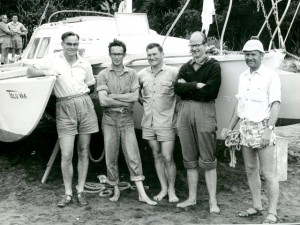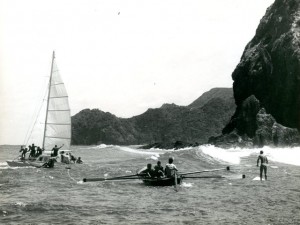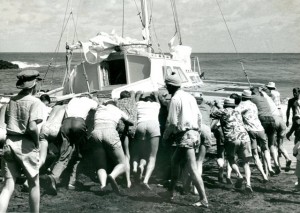In 1963, a trimaran called Tolu Vaa, sailing along the West Coast and with darkness falling, ran for shelter at Piha. With the help of the surf club, which saw the drama unfolding, the Tolu Vaa was successfully beached, all sails hoisted. At that time, a trimaran was a thing of novelty and everyone at Piha gathered to inspect the boat and theorise about how it was to be got off the beach. The Herald arrived and fortunately took a series of photos to record the event, especially the dramatic refloating.
The crew of five – Richard Hartley, Norm Hart, Jan Gorter, Athol Gubb and Jeff Morris – was well looked after at Piha, with good food, warming whiskeys, dry clothes and warm beds. They were celebrities though not a few would have quietly declared them inexperienced fools for taking on the surf of Piha in their craft.
After some days, when the weather calmed down, the Tolu Vaa was prepared for refloating.
It would surprise no one that the person who took control of this operation was Tom Pearce, and older surf club members still vividly remember the operation which was accomplished by virtue of the use of a sea-anchor.
The owner of the Tolu Vaa wrote all this up and it was published in the now defunct magazine Power Boat and Yachting in 1963 under the title “500 Miles in a Seagoing Trimaran”. Recently, Piha local Graeme Webber has seen it republished as a series in the newsletter Ferro Flyer.
In this edition of Ferro Flyer (November 2010) you can read an episode of the story.FERRO FLYER Nov 2010
Next is the transcript of the second installment.
500 Miles in a Seagoing Trimaran (Power Boating and Yachting Apr ’63) cont’d ::
We left off last month with Richard Hartley’s Dark was closing in when Lion Rock, to the North of Piha Beach, was sighted ………
A hurried compass bearing showed we were being carried up the coast by a strong tidal set, so the course was altered to take us directly off the rocks at the southern end of Piha Beach.
By turning and running directly for the beach we had the wind and sea right behind us. The current carried us up the coast clear of the rocks, perfectly, until we hit a tidal set further in, running down the coast on to the rocks. This forced us to run at an angle to the following sea, right on the point of a jibe, with the full float to leeward. At this point Tolu Vaa was committed. The boom was lashed so it could not jibe, the dinghy turned right side up ready to float off, the anchor made ready if necessary, and spare rope broken out in the hope there would be somebody ashore to give us a hand to get the trimaran out of the surf before she broke up.
The stern of the trimaran rose to a sea made deeper by the beach still a mile away, and she drove straight on under the press of her lashed mainsail and jib combined now with the drive of curling ocean coamers. The stern rose again higher and higher. A short view of neatly dressed – ready to go to a dance – surf club boys sitting on surf skis, some stationed outside the rocks and reefs and waving us clear of them, and one straight ahead ready to board us and take us in. We ran him down !!
The sea crashed on over the stern filling the cockpit, pounding us up against the after end of the cabin. The full float drove 3 to 4 feet under the water and Tolu Vaa started to broach and heel at an alarming angle. Two of us heaved the helm over and she straightened out for the beach again, with the lee float surfacing as the bulk of the wave passed beneath us.
By this time we were really travelling, but the next sea lifted Tolu Vaa and hurled her with even greater force towards the beach. The timber side decks erupted in a mass, and a capsized surf board shot endwise bodily out of the water. This 2nd and biggest wave roared right on over the stern with even greater violence than the first but this time we were braced by the waist deep water already in the cockpit, and were able to retain our hold on the tiller, Tolu Vaa did as all sea-going trimarans should do. She surfed on and answered her helm. Another sea broke aboard but we were through the worst. A surf Club member on a ski waved us off a reef and another further in waved us in behind it where we belted straight in to the beach with all sail still drawing. The full float hit first and a following sea slewed us partly side on to the sea. A bronzed sea elephant of a man with a bull voice, ordered us to take the sail off the trimaran and everybody on the beach to unload the ship immediately. We had met Tom Pearce himself!
Piha deluged us with hospitality. Athol and myself found ourselves whisked off to a private home where a hot bath was waiting. Half a glass of whiskey was pressed into our hands while sitting in the bath. I am a beer man myself, so Athol drank both lots. Another two glasses came in. By the time the bath was finished, Athol was reasonably happy about the whole affair.
Next day a post mortem was held. A pulled off ventilator was discovered under the dinghy which explained the float filling. The whole boat was thoroughly gone over and there was no damage anywhere at all except the timber side decks. The ¼ plywood float had taken the hardest battering particularly when it hit the beach full of water, but it was completely undamaged. I am firmly of the opinion if the side decks had been made of two layers of ¼ plywood, as specified, it would not have broken up as it did. The plywood slide which acts as a door into the main cabin did not give although the water surged over the top of it.
I paid particular attention to the cockpit and cockpit coamings. These members were only 3/8 plywood and they were undamaged and not strained in any way. Norm had intended to fasten two knees to the deck and coamings to hold them but had not done so. Even so, they had not broken.
To be continued…….
We will have to wait for the 3rd installment.





